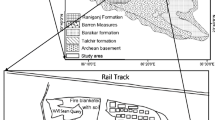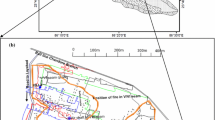Abstract
The present study deals with the mapping and understanding of sub-surface coal fire on the basis of magnetic susceptibility of materials that changes with the temperatures rise above or below the Curie temperature. The magnetic data acquisition has been carried out using high resolution GSM-19T proton precession magnetometer. The acquired magnetic data have been processed and analyzed to study magnetic field anomaly of East Basuria Colliery in Jharia coalfield, Jharkhand, India for mapping and understanding of sub-surface coal fire. Residual component of the total magnetic field anomaly map of the area has been calculated to enhance and delineate the coal fire region.
Similar content being viewed by others
References
Agarwal, R., Singh, D., Chauhan, D.S. and Singh, K.P. (2006) Detection of coalminefires in the Jharia coal field using NOAA/AVHRR data. Jour. Geophys. Engg., v.3, pp.212–218.
Banerjee, S.C., Nandy, D.K., Banerjee, D.D. and Chakravorty, R.N. (1972) Classification of coal with respect to their susceptibility to spontaneous combustion. Trans. Min. Metall. Inst. India, v.59(2), pp.15–31.
Bartel, L.C. (1982) Evaluation of the CSAMT geophysical technique to map abandoned coal mine fires. Contract DEAC04-76DP00789. Department of Energy, Sandia National Laboratories, Albuquerque, New Mexico, U.S.A. In: Proc. 52nd Annual Internat. Meet. Soc. Explor. Geophys., Dallas, Texas, U.S.A., pp.419–421.
Bell, F.G., Bullock, S.E.T., Halbich, T.F.J. and Lindsay, P. (2001) Environmental impacts associated with an abandoned mine in the Witbank Coalfire, South Africa. Int. Jour. Coal Geol., v.45, pp.195–216.
Bhattacharya, A., Reddy, S. and Mukherjee, T. (1991) Multi-tier remote sensing data analysis for coal fire mapping in Jharia coal field of Bihar, India. Asian Conf. on Rem Sens., Singapore, 30 October–5 November 1991, v.1, pp.22-1-6.
Chandra, D. (1992) Jharia Coalfields, Geol. Society of India, Bangalore, pp.149.
Chatterjee, R.S. (2006) Coal fire mapping from satellite thermal IR data — a case example in Jharia coalfield, Jharkand, India. ISPRS Jour. Photogram. Rem. Sens., v.60, pp.113–128.
CMPDI (2003) Scheme for Dealing with Fire for Protection of KT Link Line at East Busseriya colliery, pp.1-16.
Den, W., Wan, Y. and Zhao, R. (2001) Detecting coal fires with a neural network to reduce the effect of solar radiation on Landsat Thematic Mapper thermal infrared images. Int. Jour. Rem. Sens., v.22, pp.933–944.
Duba, A. (1983) Electrical conductivity of Colorado oil shale to 900°C. Fuel, v.62, pp.966–972.
Gielisch, H. (2007) Detecting concealed coal fires. Rev. Engg. Geol., v.18, pp.199–210.
Greene, G.W., Moxham, R.M. and Harvey, A.H., (1969) Aerial infrared surveys and borehole temperature measurements of coal minefires in Pennsylvania[C]. Remote Sens. Environ., v.VI (1), 517p.
Hooper, R.L. (1987) Factors affecting the magnetic susceptibility of baked rocks above a burned coal seam. Int. Jour. Coal Geol., v.9, pp.157–169.
Ide, T.S., Crook, N., and Orr Jr., F.M. (2011a) Magnetometer measurements to characterize a subsurface coal fire. Int. Jour. Coal Geol., v.87, pp.190–196.
Ide, T.S., Pollard, D. and Orr Jr., F.M. (2011b) Comparison of methods to estimate the rate of CO2 emissions and coal consumption from a coal fire near Durango,CO. Int. Jour. Coal Geol., v.86, pp.95–107.
King, A. (1987) Cindered coal detection using transient electromagnetic methods. Geoexploration, v.24, pp.367–379.
Kuenzer, C., Zhang, J., Hirner, A., Bo, Y., Jia, Y. and Sun, Y. (2005) Multi-temporal in situ Mapping of the Wuda Coal Fires from 2000 to 2005 — Assessing Coal Fire Dynamics. Proc. Int. Conf. on Coal Fire Res., Beijing, China, pp.104–106.
Kuenzer, C., Zhang, J., Li, J., Voigt, S., Mehl, H. and Wagner, W. (2007) Detection of unknown coal fires: synergy of coal fire risk area delineation and improved thermal anomaly extraction. Int. Jour. Rem. Sens., v.28, pp.4561–4585.
Lohrer, C., Schmidt, M. and Krause, U. (2005) Influence of Environmental Parameters on the Self Ignition of Coal. Proc. of the Int. Conf. on Coal Fire Research, Beijing, China, pp.110–112.
Mazumdar, T.J., Pal, S.K. and Bhattacharya, A.K., (2012) Generation of Emissivity and Land Surface Temperature Maps using MODIS TIR Data for lithological Mapping over the Singhbhum-Orissa Craton, Jour. Geol. Soc. India, v.80, pp.685–699.
Michalski, S.R. (2004) The Jharia mine fire control technical assistance project: an analysis. Int. Jour. Coal Geol., v.59, pp.83–90.
Mishra, R.K., Bahuguna, P.P. and Singh, V.K., (2011) Detection of coal mine fire in Jharia Coal Field using Landsat-7 ETM+ data. Int. Jour. Coal Geol., v.86, pp.73–78.
Munshi, P.L. (1995) Experience of dealing with fires in Jharia Coalfield–Introduction to Diagnostic Technique, National seminar on Minefires. Dept. of Mining Engineering, Institute of Technology, Banaras Hindu University, pp.82–90.
Pal, S.K., Vaish, J., Kumar, S. and Bharti, A.K. (2015) Coalfire mapping of East Basuria Colliery, Jharia coal field using Vertical Derivative Technique of Magnetic data. Jour. Earth System Science (accepted).
Prakash, A. and Gupta, R.P. (1999) Surface fires in JCF, India–their distribution and estimation of area and temperature from TM data. Int. Jour. Rem. Sens., v.20, pp.1935–1946.
Rosema, A., Guan, H., Genderen, J.L.V., Veld, H., Vekerdy, Z., Katen, A.M.T, Prakash, A. and Sharif, M. (1999) Manual of coal fire detection and monitoring, Report of the Project: Development and Implementation of a Coal Fire Monitoring and Fighting System in China, 245p.
Saraf, A.K., Prakash, A., Sengupta, S. and Gupta, R.P. (1995) Landsat-TM data for estimating ground temperature and depth of subsurface coalfire in the Jharia coalfield, India. Int. Jour. Rem. Sens., v.16, pp.2111–2124.
Schaumann, G., Siemon, B. and Yu, C.C. (2008) Geophysical investigation of Wuda Coal Mining Area, Inner Mongolia: Electromagnetics and Magnetics for coal fire detection. In: UNESCO, Mera (Ed.), Spontaneous Coal Seam Fires: Mitigating a Global Disaster. International Research for Sustainable Control and Management. ERSEC Ecological Book Series, v.4. Tsinghua University Press and Springer, Beijing, 350p.
Singh, A.K., Singh, R.V., Singh, M.P., Chandra, H. and Shukla, N.P. (2007) Mine fire gas indices and their application to Indian underground coal mine fires. Internat. Jour. Coal Geol., v.69, pp.192–204.
Shao, Z., Wang, D., Wang., Y. and Zhong, X., (2014) Theory and application of magnetic and self-potential methods in detection of the Heshituologai coalfire, China, Jour. Appld. Geophys., v.104, pp.64–74.
Singh, K.K.K., Singh, K.B., Lokhande, R.D. and Prakash, A. (2004) Multielectode Resistivity imaging technique for the study of coal seam. Jour. Sci. Ind. Res., v.63, pp.927–930.
Stracher, G.B. (2004) Coal fires burning around the world: a global catastrophe. Int. Jour. Coal Geol., v.59, pp.1–6.
Stracher, G.B. and Taylor, T.P. (2004) Coal fires burning out of control around the world: thermodynamic recipe for environmental catastrophe. Int. Jour. Coal Geol., v.59, pp.7–17.
Sternberg, R. and Lippincott, C. (2004) Magnetic surveys over clinkers and coal seam fires in Western North Dakota. Presentation at the Denver Annual Meeting of the Geological Society of America, Denver, Colorado, U.S.A., October 7-10, 2004.
van Genderen, J.L. and Guan, H. (1997) Environmental monitoring of spontaneous combustion in the North China coalfields. Final report to European Commission under contract No. Cl1–CT93–0008.
Vaish, J. and Pal, S.K. (2014) Geological mapping of Jharia Coalfield, India using GRACE EGM2008 gravity data: a vertical derivative approach, Geocarto International, DOI:10.1080/10106049.2014.905637.
Zhang, X.M. (1998) Coalfires in North-west China, Detection, Monitoring and Prediction using Remote Sensing data. ITC PhD. thesis, pp.69–70.
Author information
Authors and Affiliations
Corresponding author
Rights and permissions
About this article
Cite this article
Vaish, J., Pal, S.K. Subsurface coal fire mapping using magnetic survey at East Basuria Colliery, Jharkhand. J Geol Soc India 86, 438–444 (2015). https://doi.org/10.1007/s12594-015-0331-3
Received:
Accepted:
Published:
Issue Date:
DOI: https://doi.org/10.1007/s12594-015-0331-3




